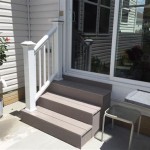Repairing Cracks in Concrete Patio: A Comprehensive Guide
Concrete patios, integral to outdoor living spaces, are susceptible to cracking over time. These cracks, while often aesthetically displeasing, can also compromise the structural integrity of the patio, leading to more significant problems if left unaddressed. Understanding the causes of concrete patio cracks and employing appropriate repair techniques is crucial for maintaining a durable and visually appealing outdoor area. This article provides a detailed guide on identifying, assessing, and repairing cracks in concrete patios.
Cracks in concrete patios arise from a variety of factors, encompassing both environmental conditions and structural deficiencies. The most common causes include shrinkage during the curing process, freeze-thaw cycles, settling of the ground beneath the patio, and overloading of the concrete slab. Recognizing the specific cause of the crack is important for selecting the most effective repair method and preventing future occurrences.
Shrinkage cracks are often hairline fractures that appear shortly after the concrete is poured and cured. These cracks typically result from the evaporation of excess water from the concrete mix. Freeze-thaw cycles contribute to cracking by causing water that has seeped into the concrete to expand when it freezes, exerting pressure on the concrete matrix. Ground settling can create stresses that lead to more substantial cracks, especially if the patio is not properly supported by a compacted base. Overloading, such as placing heavy objects or vehicles on the patio, can exceed the concrete's load-bearing capacity, resulting in structural cracks.
Assessing the Cracks: Determining the Severity and Cause
The initial step in repairing concrete patio cracks is to thoroughly assess their severity and determine the underlying cause. This involves examining the width, depth, and length of the cracks, as well as observing any displacement or unevenness in the concrete surface. Hairline cracks, typically less than 1/8 inch wide, are generally considered minor and can be addressed with relatively simple patching techniques. Wider cracks, exceeding 1/4 inch, may indicate more significant structural issues and require more extensive repairs.
Depth is another crucial factor in assessing the severity of cracks. Shallow cracks, only affecting the surface of the concrete, can be repaired with surface treatments. Deeper cracks, extending through a significant portion of the concrete slab, may require filling with a structural patching material to restore the concrete's strength. Observing the pattern and direction of the cracks can provide clues about the underlying cause. For example, a network of interconnected cracks may indicate shrinkage, while a single, long crack across the patio could be due to settling or overloading.
Evaluating the surrounding area is also important. Look for signs of ground settling, such as gaps between the patio and adjacent structures, or leaning fences or walls. These indicators suggest that the soil beneath the patio is unstable and may require stabilization before repairing the cracks. Furthermore, inspect the drainage around the patio to ensure that water is properly diverted away from the concrete surface. Poor drainage can exacerbate freeze-thaw damage and contribute to cracking.
Once the cracks have been thoroughly assessed, a determination can be made regarding the appropriate repair method. For minor hairline cracks, a simple patching compound may suffice. For wider or deeper cracks, more robust materials, such as epoxy or concrete patching mixes, may be necessary. If the cracks are caused by settling or structural issues, addressing the underlying problem is crucial to prevent the cracks from recurring. In some cases, it may be necessary to consult with a structural engineer to determine the best course of action.
Repairing Hairline Cracks: Surface Patching Techniques
Hairline cracks, characterized by their narrow width and shallow depth, are typically addressed with surface patching techniques. These techniques involve cleaning the crack, applying a patching compound, and smoothing the surface to create a seamless repair. The most common materials used for patching hairline cracks include concrete crack filler, acrylic patching compound, and epoxy injection systems. The choice of material depends on the specific characteristics of the crack and the desired aesthetic outcome.
Before applying any patching material, the crack must be thoroughly cleaned to remove any loose debris, dirt, or contaminants. This can be accomplished using a wire brush, a chisel, or a pressure washer. Ensuring a clean surface is critical for proper adhesion of the patching material. If the crack is particularly dirty or oily, a degreaser may be necessary to remove stubborn residues.
Once the crack is clean, the patching compound can be applied. Concrete crack filler is a readily available and affordable option for repairing hairline cracks. It is typically applied with a putty knife or a trowel, ensuring that the compound fills the entire crack. Acrylic patching compound offers improved flexibility and adhesion compared to concrete crack filler, making it suitable for cracks that may experience slight movement. Epoxy injection systems are more complex to use but provide superior strength and durability, making them ideal for cracks that are subject to heavy loads or frequent freeze-thaw cycles.
After the patching compound has been applied, it should be smoothed with a trowel or a sponge to blend it seamlessly with the surrounding concrete surface. Allowing the patching compound to dry completely, as per the manufacturer's instructions, is essential before subjecting the repaired area to traffic. In some cases, several coats of patching compound may be necessary to completely fill the crack and achieve a smooth, even surface.
For added protection and aesthetic improvement, a concrete sealer can be applied to the repaired area. Concrete sealers help to prevent water penetration, which can contribute to future cracking, and also enhance the appearance of the concrete surface. Choosing a sealer that is compatible with the patching compound and the existing concrete is crucial for optimal performance.
Repairing Larger Cracks: Structural Patching Methods
Wider and deeper cracks in concrete patios require more robust repair methods that address the structural integrity of the concrete. These methods typically involve widening the crack, cleaning it thoroughly, and filling it with a structural patching material, such as epoxy mortar or concrete mix. The choice of material depends on the width and depth of the crack, as well as the load-bearing requirements of the patio.
The first step in repairing larger cracks is to widen the crack using a chisel or a concrete saw. This creates a wider opening that allows for better access to the interior of the crack and provides a larger surface area for the patching material to bond to. The crack should be widened to a minimum of 1 inch wide and 1 inch deep to ensure adequate filling with the patching material.
After widening the crack, it must be thoroughly cleaned to remove any loose debris, dirt, or contaminants. This can be accomplished using a wire brush, a chisel, or a pressure washer. In some cases, it may be necessary to use a concrete grinder to remove any loose or crumbling concrete from the edges of the crack. Ensuring a clean and stable surface is crucial for proper adhesion of the patching material.
Once the crack is clean, the structural patching material can be applied. Epoxy mortar is a popular choice for repairing larger cracks due to its high strength, durability, and resistance to water penetration. It is typically mixed according to the manufacturer's instructions and applied with a trowel, ensuring that the entire crack is filled. Concrete mix can also be used for repairing larger cracks, but it is important to choose a mix that is specifically designed for patching concrete. The concrete mix should be mixed with water to a consistency that allows it to be easily worked into the crack.
After the patching material has been applied, it should be compacted and smoothed with a trowel to ensure that it is level with the surrounding concrete surface. Allowing the patching material to cure completely, as per the manufacturer's instructions, is essential before subjecting the repaired area to traffic. In some cases, it may be necessary to apply multiple layers of patching material to completely fill the crack and achieve a smooth, even surface. A concrete float can be used to finish the surface for a smoother appearance.
For added strength and durability, reinforcement bars or wire mesh can be inserted into the crack before applying the patching material. This is particularly beneficial for cracks that are subject to heavy loads or frequent movement. The reinforcement bars or wire mesh should be securely anchored in the concrete on either side of the crack to provide maximum support.
Preventative Measures: Maintaining Concrete Patio Integrity
Preventing cracks in concrete patios is often more effective than repairing them. Implementing preventative measures during the initial construction and throughout the patio's lifespan can significantly reduce the likelihood of cracking and extend its overall durability. These measures encompass proper site preparation, appropriate concrete mix design, adequate drainage, and regular maintenance.
Proper site preparation is crucial for a stable and durable concrete patio. This involves ensuring that the soil beneath the patio is well-compacted and properly graded to prevent settling. Removing any organic matter, such as roots or vegetation, is also essential to prevent decomposition and soil instability. A well-compacted gravel base should be installed beneath the concrete slab to provide additional support and drainage.
The concrete mix design should be appropriate for the intended use of the patio and the local climate conditions. Using a high-quality concrete mix with a low water-to-cement ratio can help to minimize shrinkage and cracking. Adding fiber reinforcement to the concrete mix can also improve its tensile strength and resistance to cracking. Consulting with a concrete specialist to determine the optimal mix design for the specific application is recommended.
Adequate drainage is essential for preventing water penetration and freeze-thaw damage. The patio should be sloped slightly away from the house to ensure that water is properly diverted. Installing drainage systems, such as French drains or surface drains, can also help to remove excess water from the patio area. Regularly cleaning gutters and downspouts to prevent overflows that could saturate the surrounding soil is essential.
Regular maintenance, including cleaning and sealing, can help to protect the concrete surface and prevent cracking. Concrete patios should be cleaned regularly to remove dirt, debris, and stains. Using a mild detergent and a brush is typically sufficient for routine cleaning. Applying a concrete sealer every few years can help to prevent water penetration, protect against staining, and enhance the appearance of the concrete surface. Inspecting the patio regularly for signs of cracking and addressing any minor issues promptly can prevent them from escalating into more significant problems.

5 Ways To Fix Cracked Or Damaged Concrete Patio Cricket Pavers

How To Fix Cracks Crumbles And Breaks In Concrete Dap Global

Cracked Concrete Patio Restoration For 60 Youtube

How To Fix Cracked Concrete Putting Two Methods The Test Renee Renovates

5 Key Considerations For Concrete Repairs Sakrete

Repairing A Neglected Driveway Crack The Ultimate Solution

How To Fill Seal Caulk Concrete Cracks Best Repair Methods Diy Guide

Concrete Crack Repair Guide How To Fix Cracks In Slabs Network

How To Fix Cracks Crumbles And Breaks In Concrete Dap Global

5 Ways To Make Concrete Patio Repairs Bob Vila








